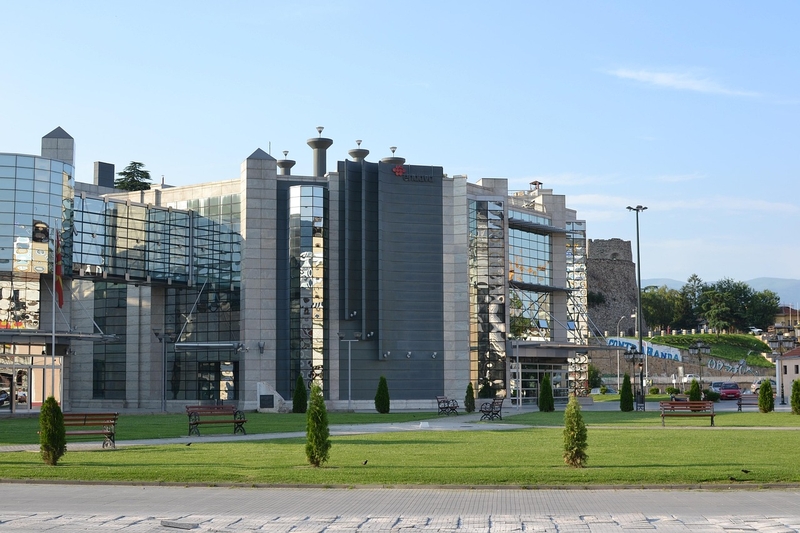
Over the past decade, Skopje, North Macedonia, has undergone a dramatic transformation aimed at shaping a stronger national identity and raising its international profile. In particular, the Skopje 2014 initiative channeled over $700 million into an ambitious redesign of the city center, featuring dozens of neoclassical facades, embellished bridges, and more than 280 statues—including the towering, 73-foot figure of Alexander the Great, now a magnet for tourist selfies. But as 2028 approaches, and with it the opportunity to serve as the European Capital of Culture, it’s worth asking: is Skopje truly ready?
Before 2010, North Macedonia drew fewer than 500,000 tourists annually, despite its rich heritage—home to Byzantine churches, Roman ruins, Ottoman bazaars, and Lake Ohrid, a UNESCO World Heritage site. The Skopje 2014 project was designed to change that by visually rebranding the capital into a grand stage of national pride. According to government reports, the project included 136 new or renovated buildings, 30 bridges, and an aesthetic overhaul of many brutalist-era structures. At its peak, Skopje 2014 consumed nearly 10% of the country’s annual tax revenue, a staggering investment for a state with a per capita GDP just over $4,000.
The results are mixed. Tourism has grown: international arrivals have more than doubled, topping 1.1 million in recent years (UNWTO), while flights to Skopje Airport are up 23% compared to pre-2014 levels (TAV Macedonia). Hostels and hotels are notably busier, and the city has undeniably gained visibility on the global map. Even critics admit: “the country is getting noticed.”
Yet, for many Macedonians, the project sparked frustration rather than pride. Allegations of corruption, opaque contracts, and overnight statue installations fueled outrage. As one guide in Skopje put it, “Corruption and construction are like brother and sister here.” The issue was not merely one of taste but of priorities: in a country with underfunded healthcare and high youth unemployment, critics saw Skopje 2014 as spectacle over substance.
What Skopje Still Needs for 2028
The European Capital of Culture title is not just an award—it's a challenge and an opportunity. Cities must demonstrate cultural vibrancy, accessibility, hospitality, and long-term benefit. Based on my recent visit, as well as my experience working in Nashville’s cultural revitalization and tourism strategy, here’s where Skopje needs to improve:
1. Hospitality and Tourism Readiness
Skopje’s hospitality sector has grown, but accommodation and service standards remain uneven. Many restaurants and cafés cater mainly to locals, lacking foreign-language menus or staff trained in customer service. Credit card acceptance is inconsistent. For 2028, the city should:
- Expand hotel capacity, including mid-range and boutique options.
- Offer hospitality training programs to improve service quality.
- Ensure widespread adoption of digital payment systems.

2. Transportation and Accessibility
Reliable infrastructure is essential to a smooth visitor experience. Skopje’s public buses are outdated, schedules unreliable, and signage is often monolingual. International connections are improving but still limited. To strengthen accessibility, the city should:
- Upgrade the public transit fleet and provide multilingual route signage.
- Improve road and rail links to nearby regional hubs.
- Expand and modernize Skopje International Airport.
3. Cultural Infrastructure
While the Museum of Contemporary Art stood out with its striking hilltop location and strong programming, other venues were less impressive. We saw a bucket on the floor catching a leak from an aging ceiling—symbolic of broader infrastructural decay. Many venues lack basic climate control, accessibility features, or modern lighting and sound systems. To elevate its cultural offering, Skopje should:
- Renovate key cultural institutions with EU accessibility and energy-efficiency standards.
- Partner with local artists and international advisors for curation and programming.
- Digitally map and promote its diverse cultural offerings.
4. Public Space and City Cleanliness
Many parks and public spaces are under-maintained. On our visit, we noticed broken benches, scattered litter, and overgrown green areas—even near major monuments. These seemingly small issues affect how visitors and locals perceive the city. Suggested improvements include:
- Implementing a modern waste management system with visible, well-placed trash bins.
- Hiring more public maintenance crews, especially for parks and pedestrian zones.
- Creating incentives for local businesses to sponsor public space upkeep.
How Can Skopje Pay for These Investments?

Hosting a European Capital of Culture year is expensive—but not unaffordable. Cities like Rijeka (2020) and Essen (2010) used a combination of EU cultural funds, public-private partnerships, and municipal bonds. Skopje might also consider:
- Tourism-based taxes, such as a small visitor levy earmarked for cultural infrastructure.
- International development loans, conditional on transparency and sustainability.
- Public crowdfunding for flagship venues, engaging the diaspora and local civic pride.
From my work in Nashville, I’ve seen how smart cultural investment pays off. When the city revitalized its downtown arts corridor and pedestrianized key areas, tourism soared, businesses flourished, and local pride deepened. Nashville’s approach blended grassroots cultural programming with strategic infrastructure upgrades, positioning it as both a music capital and a dynamic urban center.
Skopje can do the same—if it learns from its past and plans for its future.
Conclusion: More Than a Title
As Skopje prepares for 2028, it stands at a crossroads. The city has succeeded in catching the world’s eye. But now it must earn its admiration. The next steps are not about erecting more statues or grand facades but about refining the infrastructure, fostering inclusive cultural growth, and investing wisely in the public good.
If approached with transparency, creativity, and long-term vision, Skopje 2028 could become more than just a one-year event. It could be a launching pad for a more sustainable, welcoming, and proudly Macedonian cultural future.